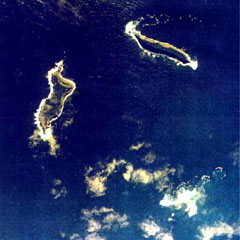Report on Hunga Tonga-Hunga Ha'apai (Tonga) — 22 December-28 December 2021
Smithsonian Institution / US Geological Survey
Weekly Volcanic Activity Report, 22 December-28 December 2021
Managing Editor: Sally Sennert.
Please cite this report as:
Global Volcanism Program, 2021. Report on Hunga Tonga-Hunga Ha'apai (Tonga) (Sennert, S, ed.). Weekly Volcanic Activity Report, 22 December-28 December 2021. Smithsonian Institution and US Geological Survey.
Hunga Tonga-Hunga Ha'apai
Tonga
20.5532°S, 175.3841°W; summit elev. 114 m
All times are local (unless otherwise noted)
The eruption at Hunga Tonga-Hunga Ha'apai that began on 20 December continued through 28 December. According to the Wellington VAAC continuous gas-and-steam plumes with diffuse ash rose 6.1-12.2 km (20,000-40,000 ft) a.s.l. and drifted NE and NNE during 22-23 December, based on pilot observations, satellite images, information from the Tonga Meteorological Office, and weather models. On 22 December Tonga Navy crew sailing near the island recorded Surtseyan explosions ejecting tephra 350 m high. The video confirmed that the vent was in the same area as the 2014 activity. According to a news article plumes of sulfur dioxide spread NNE over the Ha'apai, Vava'u, and Niuatoutapu island groups with the highest concentrations affecting the ‘Otumu‘omu‘a islands on 23 December.
Plumes became intermittent by 24 December rising to 10.4 km (34,000 ft) a.s.l. and occasionally as high as 12.2 km. Tonga Geological Services warned the public to stay outside of a 5 km radius of the vents. According to Tonga’s Lead Geologist, satellite images from 25 December showed that the island had grown 300-600 m on the E side, and ash was falling within a 10 km radius. During 25-28 December the gas-and-steam plume rose 9.1-12.2 km (30,000-40,000 ft) a.s.l. and drifted N and NE; the lower part of the plume contained ash and rose as high as 3 km (10,000 ft) a.s.l. Ashfall was confined to the vicinity of the volcano. Tonga Geological Services reported that during 27-28 December clouds of gas and steam drifted E across the ‘Otu Mu’omu’a Islands of Ha’apai at altitudes of 1-18 km (3,300-59,000 ft) a.s.l.; they warned residents to protect water reservoirs because rain may be acidic or contain traces of ash, though the plumes were predominantly drifting at high levels. One flight to Tonga was canceled on 28 December, for the second time since the eruption started.
Geological Summary. The small andesitic islands of Hunga Tonga and Hunga Ha'apai are part of the western and northern remnants of the rim (~6 km diameter) of a largely submarine caldera located about 30 km SSE of Falcon Island. The topmost sequence of welded and unwelded ignimbrite units from a caldera-forming eruption was 14C dated to 1040-1180 CE (Cronin et al., 2017; Brenna et al. 2022). At least two additional welded pumice-rich ignimbrite units and nonwelded pyroclastic flow deposits, below paleosols and other volcaniclastic deposits, indicated more very large previous eruptions (Cronin et al., 2017; Brenna et al. 2022). Several submarine eruptions have occurred at this caldera system since the first recorded eruption in 1912, including 1937 and S of the islands in 1988. A short eruption in 2009 added land to to Hunga Ha'apai. At that time the two islands were each about 2 km long, displaying inward-facing sea cliffs with lava and tephra layers dipping gently away from the caldera. An eruption during December 2014-January 2015 was centered between the islands, and combined them into one larger structure. Major explosive eruptions in late 2021 initially reshaped the central part of the combined island before stronger activity in mid-January 2022 removed most of the 2014-15 material; an even larger eruption the next day sent an eruption plume high into the stratosphere, triggered shock waves through the atmosphere and tsunami across the Pacific Ocean, and left only small remnants of the islands above the ocean surface.
Sources: Wellington Volcanic Ash Advisory Center (VAAC), Tonga Meteorological Services, Government of Tonga, Tonga Geological Services, Government of Tonga, Kaniva Tonga, Kaniva Tonga, Matangi Tonga Online, Matangi Tonga Online, Matangi Tonga Online, Matangi Tonga Online, Matangi Tonga Online, Matangi Tonga Online

